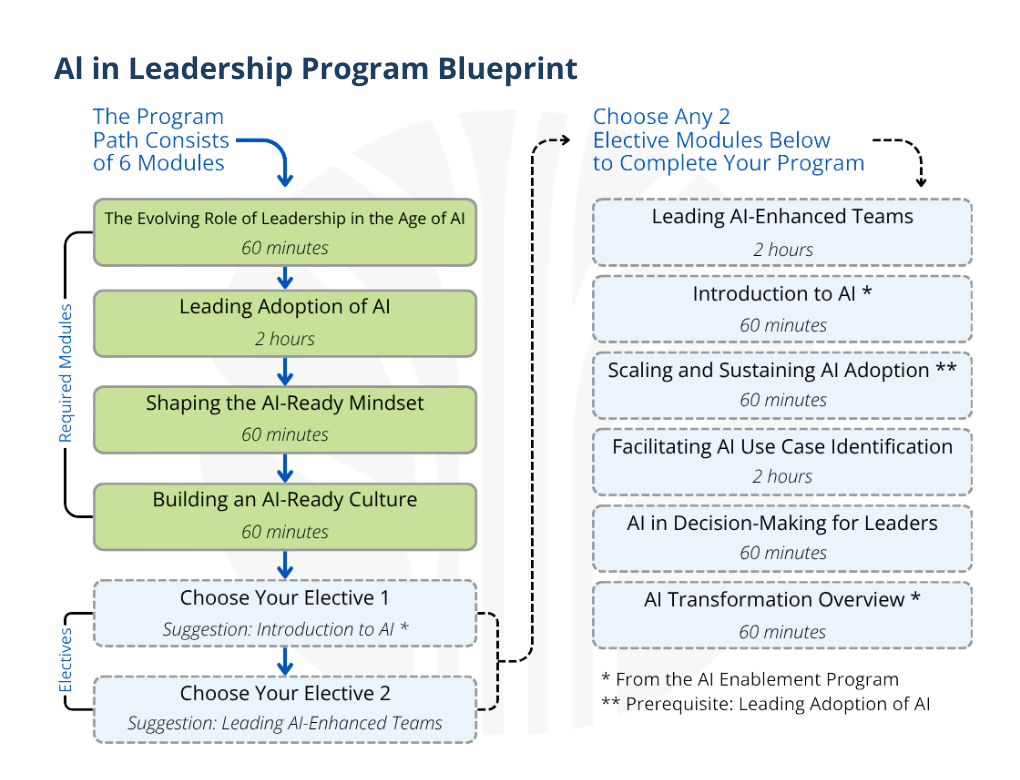Article Highlights
- True AI leadership extends beyond technology adoption, cultivating a mindset of innovation and collaboration.
- Achieving balance between AI's data-processing power and human capabilities such as empathy, vision, and creativity is key to boosting engagement.
- Leading through change effectively requires fostering trust, transparency, and AI fluency to overcome team apprehension.
- Developing practical skills to responsibly govern AI initiatives transforms technological disruption into a competitive advantage.

Artificial Intelligence (AI) is fundamentally transforming modern leadership. Leaders today must not only manage teams but also guide their organizations through continuous technological disruption. To succeed, leaders need a new level of readiness, strategic enablement, and technological fluency. This shift is not just about adopting tools; it’s about building the strategic capacity to thrive amid complexity and deliver measurable results. Building credible AI readiness is a critical first step supported by research on what separates leaders from laggards in AI readiness.
Defining True AI Leadership
Effective AI leadership goes beyond deploying technologies. It’s about cultivating an organizational mindset that drives innovation, fosters collaboration, and navigates change with confidence. At its core, AI leadership balances strategic adaptability with deep ethical responsibility, transforming AI from a disruptive force into a partner for achieving strategic goals.
To get there, leaders must first strengthen AI readiness: understanding AI’s capabilities and limits, clarifying its role in strategy execution, and reframing AI as an amplifier of human potential, not a replacement.
"View AI as a tool, not a replacement. Leaders should focus on using AI to enhance their decision-making, not to replace their own judgment." - Ajita Srinivasan, Learning Tree Expert
Leaders can accelerate these capabilities with targeted AI training that builds fluency, confidence, and responsible use.
By aligning data-driven insights with human judgment, creativity, and ethical frameworks, leaders unlock new avenues for innovation and impact.
The Synergy of AI and Human Capabilities
AI excels at large-scale data analysis, pattern recognition, and workflow optimization. Human capabilities, empathy, strategic vision, creativity, and complex ethical decision-making, remain the bedrock of effective leadership and high-performing cultures.
A simple way to view the partnership is “doing versus being”:
- AI excels at doing. It handles repetitive, data-intensive tasks with speed and precision.
- Humans thrive in being. Leadership demands vision, compassion, and the ability to inspire and guide.
"More and more doing gets outsourced to AI, allowing humans to be who they are meant to be, kind, compassionate, and visionary." - Ajita Srinivasan
To harness this dynamic, leaders must champion AI Enablement, embedding AI into roles and workflows so teams can focus on higher-value work. Strategic workforce enablement helps streamline operations and build confidence in AI-enhanced roles.
Leading Through Change in an AI-Powered Environment
AI adoption often brings shifts that can trigger skepticism or resistance, concerns about job changes, questions of accountability, and uncertainty about outcomes. Sustained progress requires human-centered leadership as much as technical implementation.
“Even I’m scared…There’s always fear; fear of the unknown, fear of ambiguity,” admits Ganesh Ayyar, president of Cognizant’s intuitive operations and automation, acknowledging the universal emotional dimensions of AI-driven change.
Leaders can reduce friction and accelerate adoption by building trust, transparency, and adaptability. This includes promoting AI fluency at every level so employees know how tools support shared goals and feel confident using them. Practical moves include:
- Offer robust reskilling programs for AI-enhanced roles.
- Foster transparent, continuous dialogue on the purpose and progress of AI initiatives.
- Co-create change initiatives with employees to build ownership and momentum.
To strengthen these capabilities, invest in evidence-based leadership development and change management practices that translate vision into execution.
Developing the Skills to Lead in the AI Era
Leading in the AI era requires practical skills and a strategic mindset. Leaders must be able to manage change, foster a data-driven culture, and govern AI initiatives responsibly. Targeted development is a smart investment that pays off in adoption speed, risk reduction, and organizational resilience.

The Learning Tree AI in Leadership Program (AILP) supports emerging and advanced leaders in bridging the gap between technology and the human factors that determine adoption success. It provides frameworks for responsible governance, effective change leadership, and sustainable innovation, equipping leaders to build AI-ready cultures and deliver measurable impact. Complement the journey with focused management skills training to elevate communication, coaching, and stakeholder alignment during transformation.
Ethical Responsibility and Strategic Accountability
Ethical AI isn’t optional, it’s foundational. Leaders must ensure fairness, transparency, and responsible integration. Establish governance frameworks, ensure compliance with regulations like the EU AI Act, and conduct routine audits to manage risk and maintain trust. Leaders remain accountable for the outcomes produced by the systems they deploy.
"If AI makes a mistake, the leader is still going to have to be answerable." - Jonathan Gilbert, Learning Tree Leadership Coach
By addressing algorithmic bias, data privacy, and transparency, leaders turn ethics into a differentiator that strengthens credibility with employees, customers, and stakeholders.
Why Leaders Must Act Now
AI leadership is a strategic imperative. Leaders who integrate AI while elevating human creativity and judgment will build resilient, adaptive, and purpose-driven organizations.
By blending the workforce solutions of AI readiness, AI enablement, and strategic AI adoption, the next generation of leaders will drive innovation, resilience, and human connection. Now is the time to invest, align your teams, and lead with purpose toward a more empowered and successful future.
AI Leadership Frequently Asked Questions (FAQs)
What is the true role of a leader in an AI-driven organization?
In an AI-driven organization, a leader's role shifts from traditional management to strategic enablement. The focus is on guiding the organization through change, fostering a culture of innovation, and empowering teams by integrating AI as a tool to enhance human capabilities. Your primary function becomes leveraging AI to drive strategic goals while nurturing the uniquely human skills, like empathy, vision, and creativity, that technology cannot replicate.
How can I ensure our AI strategy aligns with our overall business objectives?
Aligning your AI strategy begins with a clear definition of what you want to accomplish. Rather than adopting AI for its own sake, identify specific business challenges or opportunities where AI can provide a distinct advantage. Effective AI leadership involves creating a roadmap that ties every AI initiative directly to measurable business outcomes, ensuring that technology serves as a vehicle for achieving your core strategic objectives and delivering a clear return on investment.
What are the most significant ethical considerations when implementing AI?
When implementing AI, leaders must prioritize ethical responsibility to build trust and mitigate risk. The most significant considerations include ensuring fairness by addressing potential algorithmic bias, maintaining transparency in how AI systems make decisions, and protecting data privacy. As a leader, you are ultimately accountable for the outcomes of the AI tools you deploy, making it essential to establish strong governance frameworks and compliance checks from the outset.
How do I prepare my team for the changes AI will bring?
Preparing your team for AI-driven change requires a human-centered approach focused on building confidence and capability. Start by fostering open and transparent communication about the purpose and benefits of AI to address fears of job displacement. A crucial next step is to invest in targeted reskilling and upskilling programs that equip employees with the AI fluency needed to thrive in new, augmented roles. By involving your team in the process, you can cultivate a sense of ownership and create a culture that is both resilient and adaptable.


